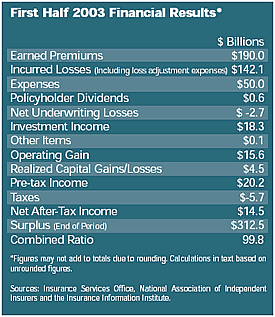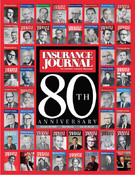The property/casualty insurance industry reported a statutory rate of return of 9.7 percent in the first half of 2003, up from a disappointing 1.0 percent in 2002 and the worst-ever negative 2.4 percent recorded in 2001. The results were released by the Insurance Services Office Inc. (ISO) and the National Association of Independent Insurers (NAII).
2003: High noon in the P/C Industry
The sun shone brightly on the P/C industry during the first half of 2003. Results through the first six months of the year have put the P/C industry on a trajectory towards its best profit performance since 1997 and its best underwriting result in a quarter century. Indeed, with a combined ratio of 99.8 through the first six months of this year, insurers could well realize their first underwriting profit since 1978.
At the same time there are telltale signs that the industry may be getting ahead of itself in terms of rebuilding capacity, which surged by 9.9 percent during the first half of the year, compared to growth in the overall economy of 4.1 percent (nominal) over the same period. Pricing power appears to be on the wane as revenue growth continues to moderate.
In the remainder of this commentary, we provide a detailed discussion of what the first half’s results mean for the industry in the context of major challenges insurers face today—many of which don’t appear on financial statements.
Revenge of the nerds: Underwriters and actuaries save the day
Losses drive performance. Underwriters who choose risks for insurance companies and the actuaries who price them have this fundamental principle hammered into their heads from the day they are hired—now people are finally listening to them. The most important piece of information—by far—to emerge from the first half results is the remarkable turnaround in the industry’s underwriting performance—from a combined ratio of nearly 116 in 2001 to just under 100 through the first six months of 2003. In terms of dollars, underwriting losses are on track to fall from a record $52 billion in 2001 to just $4 billion to $6 billion this year—a decline of roughly 95 percent.

The majority of this improvement is due to a disciplined approach to risk selection and better matching of price to the risk assumed. Investment considerations are clearly no longer driving underwriting decisions, nor should they.
To underscore the importance of this final point, consider that a combined ratio of 100 today generates a rate of return of about 9.5 percent while in 1978, the last time the industry broke even from an underwriting standpoint, the same result would have produced an ROE of about 16 percent. In fact, the combined ratio from 1977 through 1979 averaged 98.4, just a hair better than the 99.8 figure for the first half of this year, yet insurers enjoyed an average return on equity during that period of 17.5 percent. The difference, of course, was that the cash that poured in during the hard market of the mid-to-late 1970s could be invested at sky high interest rates that dwarf today’s puny yields.
The implications are sobering. As good as the first half results are, they’re simply not good enough. Clearly those guys with the pocket protectors still have a lot of work to do. A combined ratio of 99 or 100 still produces big “losses” from the point of view of disappointed investors who could have earned more elsewhere, perhaps with less risk. Investors are looking at ROEs in the neighborhood of 13 to 14 percent for the Fortune 500 this year compared to less than 10 percent in the P/C insurance world. Moreover, if nearly every penny of premium income is paid out for losses and expenses, not a nickel is left for anything else—like profits or funds needed to expand the business or offset adverse reserve development. Insurers today need to push their combined ratios down to the low 90s (and keep them there) before they can expect to generate Fortune 500 type rates of return.
P/C insurance: A $400 billion business?
Net written premiums during the first quarter totaled $202.8 billion, up a healthy 11.0 percent from the same period last year—putting the industry on track to exceed $400 billion in net premiums written for the first time in its history. While net premium growth during the quarter was undeniably strong, the modest deceleration from 12.7 percent during the first quarter and 2002’s 14.1 percent rate of growth must be noted. Nevertheless, even with sequential deceleration in premium growth through the remainder of this year, 2003 will still likely rank as the second-best year in terms of premium growth since 1987. By 2006 P/C insurance will likely pass the half trillion dollar mark in terms of net premiums written.
Investment income: How low can it go?
Rising investment income was once taken as a given in the P/C industry. These earnings, which consist primarily of interest earned from insurers’ bond holdings, rose in 21 of the 23 years from 1975 though 1997. In four of the past five years (1998 – 2002), however, as well in the first quarter of 2003, investment income has declined.
The good news is that investment income will likely increase for the foreseeable future, as evidenced by the 2.1 percent increase in the first half results. Investment income will likely rise in future quarters for a variety of reasons:
Cash flow is improving. Even with declining interest rates during the second quarter, the increase in investable funds is beginning to turn the tide in favor of greater (though still not great) gains. Investment income also includes dividends paid on common stock. The S&P 500 dividend yield today is about 1.9 percent compared to 1.5 percent not long ago. Improved corporate earnings and the reduction in the tax on corporate dividends, which makes dividend paying stocks more attractive, could help keep yields high and will allow insurers to keep more of their earnings on an after-tax basis.
• President Bush’s tax cut earlier this year has forced the federal budget into deficit for the foreseeable future, despite the budding economic recovery, leading to the largest deficits in the nation’s history and record borrowing by the federal government. The Congressional Budget Office is currently projecting a record $401 billion deficit for fiscal year 2003 (which ends Sept. 30, 2003). For 2004 and 2005, the deficits are a staggering $480 billion and $341 billion, respectively. Many economists view even these gargantuan figures as optimistic, and project deficits exceeding $500 billion for the next few years. State governments, looking to close yawning budget gaps, are also borrowing heavily. Contrary to recent political rhetoric on this issue, deficits do matter. Large deficits, all else equal, increase the demand for borrowed funds thereby forcing the price of those funds (interest rates) higher.
• Economic recovery in the second half of 2003 or in early 2004 will increase the demand for debt, pushing interest rates upward. Real GDP growth came in at 1.9 percent for the first half of this year, and is estimated at 3.1 percent during the second half and 3.9 percent in 2004 (Blue Chip Economic Indicators, Sept. 2003).
• Eventually the Federal Reserve will raise interest rates. Although the Fed cut its overnight lending rate for banks (the federal funds rate) to just one percent in June, it clearly has little additional maneuvering room. With an economic recovery under way, loose fiscal and monetary policy, and mammoth federal deficits, inflationary expectations will eventually build, forcing the Fed to raise rates. This could happen in 2004, though election year political forces will rally against such a hike even if warranted.
• Interest rates hit 45-year lows late in June, meaning that there’s more upside potential than downside risk when it comes to yields. Indeed since bottoming out at 3.13 percent on June 13, the yield on the 10-year Treasury note rose to 4.61 percent on Sept. 2 before settling back to 4.00 percent on Sept. 26.
• The stock market recovery that began in March, if sustained, will likely drain away assets from the bond markets as investors seek higher yields in equities, pushing bond prices down and yields up.
What About Wall Street?
Major U.S. stock markets were down in 2000, 2001 and 2002 and continued to fall until the middle of March 2003. A subsequent powerful rally on Wall Street erased the 3.6 percent first quarter loss on the S&P 500 and propelled the market to a 10.8 percent gain by the end of the second quarter. Through Friday, Sept. 26, the market was up an additional 2.5 points for a year-to-date gain of 13.3 percent. While the recent rally is a welcome respite from the markets’ dreadful performance over the past three years, enabling insurers to realize $4.5 billion in capital gains during the first half, it is still unclear if the current bull market has staying power. The S&P 500 was up nearly 18 percent for the year in early September but has fallen back sharply since then. Many analysts believe that the major stock markets indices have gotten ahead of themselves (especially the NASDAQ) and are exhibiting the same sort of “irrational exuberance” they displayed in the late 1990s and are due for a pullback.
Insurance company stock performance
Investors appear to have their doubts when it comes to insurer performance. Investors who poured billions into insurer equity offering since 2001 have in some cases been disappointed. Strength in other sectors of the economy, questions about the staying power of the current hard market, ratings downgrades and worries over a variety of other issues have made some investors less than enthusiastic about investing in the sector. This is evident in the large disparity between the P/C and multi-line insurer segments, which were up 9.8 and 0.2 percent respectively through Sept. 26 compared with 13.3 percent for the S&P 500. Broker stocks were up just 5.8 percent over the same period, though life/health insurer stocks were up 15.8 percent.
Surplus and capacity
Surplus expanded by 9.9 percent or $28.2 billion during the first half to $312.5 billion from $284.3 billion at year-end 2002. Unless the bottom falls out of the stock markets during the second half of this year or the industry is rocked by well-above losses or reserve charges clobber balance sheets more than usual, surplus for the year will likely expand for the first time since 1999. While increases in surplus are almost universally heralded as good news, there is a downside risk. Specifically, if capacity expands in what is an otherwise moribund economy, then capacity will expand faster than exposure growth. New exposures (like terrorism) can absorb some of the increased capacity, but most will seek a home with traditional property and casualty-type risks. In other words, there may be too much money chasing too little exposure. For example, 2.8 million fewer people were employed in Aug. 2003 compared to Feb. 2001 and the unemployment rate reached 6.4 percent—a 9-year high—in June. Workers’ compensation exposure growth is suffering as a result, with wage and salary disbursements remaining virtually flat. Commercial property exposure is likewise hurt by the continuing malaise in capital investment by businesses, which continued its slide into the first quarter of 2003 before showing a weak increase in the second quarter.
Summary
The first half of 2003 represents the first sustained period of truly good financial performance the property/casualty insurance has experienced since the current hard market began three years ago. The fact that the industry’s statutory return on average surplus was just 9.7 percent, despite a combined ratio of just 99.8, is a stark reminder that additional improvements in underwriting are needed if the industry hopes to generate Fortune 500 rates of return in the 12 to 15 percent range anytime soon. An uncertain investment environment, sluggish exposure growth in the midst of increasing capacity, and reserve overhangs are just a few of many areas of concern that will be interesting to watch as the industry moves into 2004.
Robert Hartwig is senior vice president and chief economist for the Insurance Information Institute. He can be reached via e-mail at bobh@iii.org.
Topics Carriers Profit Loss Excess Surplus Underwriting Property Casualty Market
Was this article valuable?
Here are more articles you may enjoy.


 Son of Ponzi-Accused Georgia Building & Loan Founder Now an Insurance Agent
Son of Ponzi-Accused Georgia Building & Loan Founder Now an Insurance Agent  Three Top P/C Insurers Account for Most of Insurance AI Patents
Three Top P/C Insurers Account for Most of Insurance AI Patents  Catastrophe Bonds Linked to Wildfires Lose ‘Untouchable’ Status
Catastrophe Bonds Linked to Wildfires Lose ‘Untouchable’ Status  UPS Ripped Off Seasonal Workers With Unfair Pay Practices, Lawsuit Alleges
UPS Ripped Off Seasonal Workers With Unfair Pay Practices, Lawsuit Alleges 


